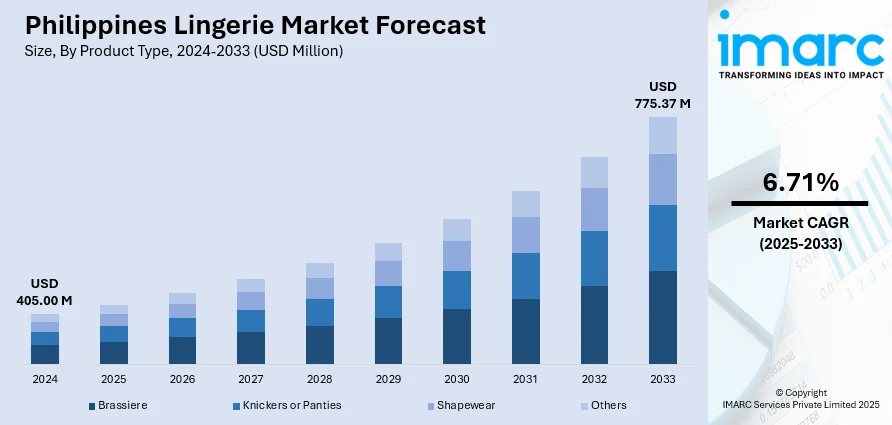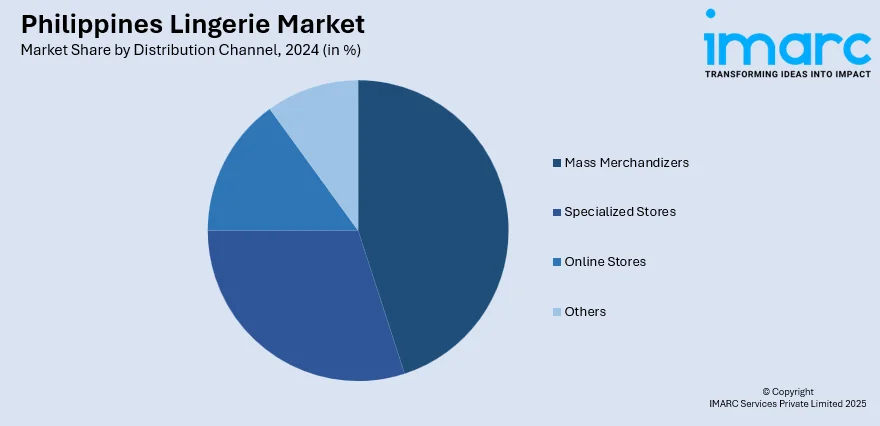
Philippines Lingerie Market Size, Share, Trends and Forecast by Product Type, Material, Price Range, Distribution Channel, and Region, 2025-2033
Philippines Lingerie Market Overview:
The Philippines lingerie market size reached USD 405.00 Million in 2024. Looking forward, the market is projected to reach USD 775.37 Million by 2033, exhibiting a growth rate (CAGR) of 6.71% during 2025-2033. The market is driven by an expanding middle class seeking higher-quality, style-conscious lingerie that aligns with evolving identity and comfort preferences. E-commerce growth, digital marketing, and influencer-led campaigns are reshaping retail access and engagement across urban and rural demographics. Additionally, locally adapted designs that prioritize climate-appropriate fabrics, fit accuracy, and modest versatility are further augmenting the Philippines lingerie market share.
|
Report Attribute
|
Key Statistics
|
|---|---|
|
Base Year
|
2024
|
|
Forecast Years
|
2025-2033
|
|
Historical Years
|
2019-2024
|
| Market Size in 2024 | USD 405.00 Million |
| Market Forecast in 2033 | USD 775.37 Million |
| Market Growth Rate 2025-2033 | 6.71% |
Key Trends of Philippines Lingerie Market:
Rising Middle-Class Population and Shifting Consumer Preferences
The growth of the middle-income demographic in the Philippines is significantly influencing lingerie purchasing behavior, creating demand for better quality, comfort, and design variety. As disposable incomes rise, Filipino consumers, particularly urban women, are moving beyond basic undergarments toward lingerie that reflects both functionality and personal style. Retailers are increasingly offering size-inclusive, skin-tone-matching, and versatile products tailored for a more informed and fashion-conscious audience. Local and international brands alike are expanding their collections to include bralettes, shapewear, seamless underwear, and eco-friendly fabrics to cater to these evolving tastes. Shopping habits are also transitioning, with consumers favoring department stores, mall-based specialty outlets, and branded online platforms offering curated recommendations and flexible return policies. This shift is not only driven by aesthetics but also by a heightened emphasis on body positivity, comfort, and self-expression. The broader cultural change, in which lingerie is viewed as an extension of personal identity rather than a hidden necessity, is contributing to a more dynamic retail landscape. These factors collectively fuel Philippines lingerie market growth, shaping the sector into a more diverse and style-forward consumer segment.

To get more information of this market, Request Sample
E-Commerce Expansion and Digital Engagement
The rapid expansion of e-commerce in the Philippines has had a transformative impact on lingerie retail, making products more accessible to a wider demographic beyond Metro Manila. Online platforms such as Lazada, Shopee, and brand-specific websites now offer detailed product information, fit guides, and customer reviews—features that mitigate the tactile limitations traditionally associated with lingerie purchases. Digital-native brands are leveraging influencer marketing and targeted advertising to attract younger consumers, using social media platforms such as Instagram, TikTok, and Facebook to showcase product aesthetics and body-positive messaging. Virtual try-on tools, easy size exchanges, and cash-on-delivery options are helping overcome barriers like sizing uncertainty and payment insecurity. Moreover, rural and suburban customers now have access to a broader range of designs, styles, and price points. This digital retail shift has also allowed smaller and independent lingerie labels to gain visibility and establish a niche presence. The scalability of e-commerce continues to level the playing field between legacy brands and new entrants, while offering personalized shopping experiences that reflect the modern Filipino consumer’s growing preference for convenience, privacy, and choice.
Localization of Design and Cultural Adaptation
Lingerie brands in the Philippines are increasingly incorporating local tastes, body types, and climate considerations into product development, moving beyond imported sizing and Western-centric aesthetics. Fabrics suited to tropical weather—such as moisture-wicking cottons, lightweight lace, and breathable modal—are in high demand. Filipino consumers also value modesty and multi-functionality, driving the popularity of lingerie that can double as outerwear or be worn discreetly under a variety of garments. Design localization also includes adapting strap lengths, cup structures, and band sizing to suit the typical Southeast Asian frame. Beyond fit, color palettes and motifs are being tailored to regional preferences, including neutral tones and minimalist styles that appeal to both younger buyers and conservative shoppers. Local brands are capitalizing on this by offering collections specifically designed for the Filipino body and climate, often marketed with cultural fluency and language familiarity. These brands also engage in values-based messaging, emphasizing sustainability, inclusivity, and women-led entrepreneurship. As lingerie becomes more attuned to the local lifestyle and preferences, customer loyalty is deepening, and repeat purchasing is increasing. This alignment of product development with domestic needs underscores the market’s long-term commercial potential.
Growth Drivers of Philippines Lingerie Market:
Urban Lifestyle Driving Lingerie Demand
According to Philippines lingerie market analysis, the country’s expanding urban population is fueling greater demand for lingerie that blends style, comfort, and self-expression. Consumers in urban areas, influenced by global fashion trends and contemporary lifestyles, are looking for products that reflect their personal style and provide functional comfort for everyday use. This group of consumers appreciates a variety of designs, high-quality materials, and innovative features, such as seamless finishes and adaptable styles suitable for both casual and formal settings. Additionally, the rising visibility of international brands and social media is shaping preferences toward more stylish and confidence-enhancing lingerie. This transformation in consumer attitudes and lifestyle priorities is significantly impacting the expanding Philippines lingerie market share.
Marketing Campaigns and Brand Collaborations Boosting Appeal
Innovative marketing campaigns and strategic collaborations are significantly increasing the visibility of the Philippines lingerie market. These efforts aim to reposition lingerie as not just an undergarment but also a means of self-expression and a lifestyle choice. Brands are utilizing social media influencers, celebrity endorsements, and body-positivity messages to resonate with a variety of consumer segments. The introduction of limited-edition collections and co-branded products is sparking interest and driving purchasing intent. By integrating broader fashion and wellness trends, these campaigns are changing consumer perceptions and normalizing lingerie as part of everyday attire. Such initiatives are essential in enhancing Philippines lingerie market demand.
Rising Demand for Premium and Specialized Lingerie
In the Philippines, there is a growing shift toward premium and specialized lingerie, driven by consumers' desires for superior quality, style, and comfort. Lingerie inspired by sportswear, featuring advanced materials and ergonomic designs, is increasingly appealing to those with active lifestyles. Additionally, body-positive collections that offer inclusive sizing and flattering cuts are helping to boost consumer confidence. This trend is further fueled by rising disposable incomes and greater exposure to international lingerie styles. Premium offerings often showcase intricate designs, sustainable materials, and innovative features, making them appealing to discerning consumers. This changing preference is a significant contributor to Philippines lingerie market growth.
Philippines Lingerie Market Segmentation:
IMARC Group provides an analysis of the key trends in each segment of the market, along with forecasts at the country and regional levels for 2025-2033. Our report has categorized the market based on product type, material, price range, and distribution channel.
Product Type Insights:
- Brassiere
- Knickers or Panties
- Shapewear
- Others
The report has provided a detailed breakup and analysis of the market based on the product type. This includes brassiere, knickers or panties, shapewear, and others.
Material Insights:
- Cotton
- Silk
- Satin
- Nylon
- Others
The report has provided a detailed breakup and analysis of the market based on the material. This includes cotton, silk, satin, nylon, and others.
Price Range Insights:
- Economy
- Premium
The report has provided a detailed breakup and analysis of the market based on the price range. This includes economy and premium.
Distribution Channel Insights:

- Mass Merchandizers
- Specialized Stores
- Online Stores
- Others
The report has provided a detailed breakup and analysis of the market based on the distribution channel. This includes mass merchandizers, specialized stores, online stores, and others.
Regional Insights:
- Luzon
- Visayas
- Mindanao
The report has also provided a comprehensive analysis of all major regional markets. This includes Luzon, Visayas, and Mindanao.
Competitive Landscape:
The market research report has also provided a comprehensive analysis of the competitive landscape. Competitive analysis such as market structure, key player positioning, top winning strategies, competitive dashboard, and company evaluation quadrant has been covered in the report. Also, detailed profiles of all major companies have been provided.
Philippines Lingerie Market Report Coverage:
| Report Features | Details |
|---|---|
| Base Year of the Analysis | 2024 |
| Historical Period | 2019-2024 |
| Forecast Period | 2025-2033 |
| Units | Million USD |
| Scope of the Report |
Exploration of Historical Trends and Market Outlook, Industry Catalysts and Challenges, Segment-Wise Historical and Future Market Assessment:
|
| Product Types Covered | Brassiere, Knickers or Panties, Shapewear, Others |
| Materials Covered | Cotton, Silk, Satin, Nylon, Others |
| Price Ranges Covered | Economy, Premium |
| Distribution Channels Covered | Mass Merchandizers, Specialized Stores, Online Stores, Others |
| Regions Covered | Luzon, Visayas, Mindanao |
| Customization Scope | 10% Free Customization |
| Post-Sale Analyst Support | 10-12 Weeks |
| Delivery Format | PDF and Excel through Email (We can also provide the editable version of the report in PPT/Word format on special request) |
Key Benefits for Stakeholders:
- IMARC’s industry report offers a comprehensive quantitative analysis of various market segments, historical and current market trends, market forecasts, and dynamics of the Philippines lingerie market from 2019-2033.
- The research report provides the latest information on the market drivers, challenges, and opportunities in the Philippines lingerie market.
- Porter's five forces analysis assist stakeholders in assessing the impact of new entrants, competitive rivalry, supplier power, buyer power, and the threat of substitution. It helps stakeholders to analyze the level of competition within the Philippines lingerie industry and its attractiveness.
- Competitive landscape allows stakeholders to understand their competitive environment and provides an insight into the current positions of key players in the market.
Key Questions Answered in This Report
The lingerie market in Philippines was valued at USD 405.00 Million in 2024.
The Philippines lingerie market is projected to exhibit a compound annual growth rate (CAGR) of 6.71% during 2025-2033.
The Philippines lingerie market is expected to reach a value of USD 775.37 Million by 2033.
The Philippines lingerie market is witnessing increased demand for inclusive sizing, body-positive designs, and multifunctional styles. Online retail channels, influencer-led marketing, and lifestyle-oriented branding are also shaping evolving consumer preferences and purchase behaviors.
Market growth is driven by rising disposable incomes, expanding urban lifestyles, and increasing emphasis on comfort and style in daily wear. Growing exposure to global fashion trends, the rise of e-commerce accessibility, and the influence of targeted marketing campaigns are further boosting consumer interest in diverse and high-quality lingerie products.
Need more help?
- Speak to our experienced analysts for insights on the current market scenarios.
- Include additional segments and countries to customize the report as per your requirement.
- Gain an unparalleled competitive advantage in your domain by understanding how to utilize the report and positively impacting your operations and revenue.
- For further assistance, please connect with our analysts.
 Request Customization
Request Customization
 Speak to an Analyst
Speak to an Analyst
 Request Brochure
Request Brochure
 Inquire Before Buying
Inquire Before Buying




.webp)




.webp)












